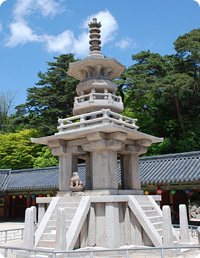WINTER OLYMPICS
Post-Olympics 3 days
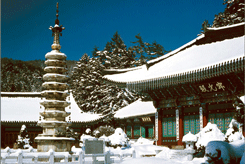
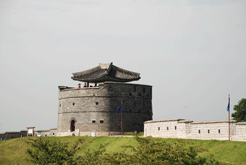
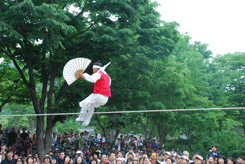
Click on the days to access the programs quick
| Days | Visits and Activities | Distance |
| Day 1 | Pyeongchang - Odaesan - Yongin - Suwon - Seoul | 260km |
| Day 2 | Seoul | |
| Day 3 | Departure | 60km |
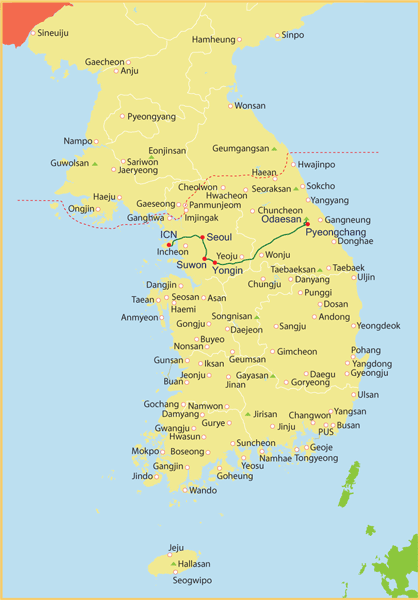 Day 1 Pyeongchang - Odaesan - Yongin - Suwon - Seoul (- - -) 260km
Day 1 Pyeongchang - Odaesan - Yongin - Suwon - Seoul (- - -) 260km
Visit Woljeongsa temple. Enshrined in the Main Hall is a statue of Sakyamuni, but the more important statue is a Bodhisattva, 1.8 meters high, probably a Medicine Bodhisattva. Said to have been found in the Diamond Pond to the south of the temple, the statue is offering something. The head is covered with a hat, the face is long and the ears are slightly hidden by long hair. Around the neck there are three lines which are so beautifully carved hat they look like necklaces. The elbow is resting on the head of a young boy. Next to the Bodhisattva is an octagonal nine-story pagoda which stands 15.2 meters high and is representative of the many-angled, many-storied stupas of the Goryeo Period. Another amazing part of the temple is the 800-meter road arched by 1,700 tall fir trees. You will stroll the path listening to the trickles of stream and smelling the fresh yet musky fir trees.
Next up is Korean Folk Village, a functioning community displaying the diversity of Korean lifestyle and culture of several centuries ago. Experience the heritage of the Korean people and soak up the local culture.
At village entrance stands an eye-catching stone tower topped by a symbolic stone serving as fertility and protective totem, where people write a wish on the paper and tie to the ropes.
On entering the village, you are greeted by goofy looking group of wooden Jangseung signifying village boundary and preventing bad luck.
Today, you will see a wide assortment of residential structures from the straw-thatched cottages of commoners to the 99-room mansions of the noble class as well as governor's office. The village also shows workshops of 20 types where the real artisans and craftsmen dressed in traditional costumes ply their trades, demonstrating centuries-old craftsmanship in the art of pottery, pyrography, bamboo craft, Korean paper, brassware, and many more. While strolling past the houses and workshops one by one, you will get the feeling of walking through time in an ancient village.
Enjoy farmer's music and dance, which has been the beloved form of entertainment of Korean people, bearing testimony to the gregarious character of Korean fun-making and festivity. Jultagi or acrobatics on a tightrope is something you cannot miss. The rope walker executes a variety of acrobatic feats on the rope, along with jokes, mimicry, or songs, while a clown engages the tightrope walker in joking banter, and a team of musicians plays music to accompany the entertainment.
You will also get to have a chance to experience some of long-observed seasonal customs, beliefs, folk games or plays that have been comprehensively reflected the daily life of the Korean people. A traditional wedding ceremony is also performed on a daily basis, although it may no longer be explicitly followed.
A traditional marketplace offers the exotic flavors of Korean cuisine from different regions. Shops stock a variety of handicrafts and souvenirs, many of which were made on the premises. With all these features combined, the tour offers a fascinating insight into the unique Korean lifestyle of the days gone by.
Later, you also explore UNESCO World Heritage site of Hwaseong Fortress from the 18th century, and learn some of Korea's long history, see beautiful natural surroundings, and get a lot of exercise all at the same time. A 5.74km-long fortress enclosing both flatland and hilly terrain is parapeted with crenels and merlons and highlighted by four main gates and well over 50 structures including temporary palace where the king sought refuge during war and found rest during times of peace.
A walk through the whole fortress could take several hours but it is well worth making a short walking tour to enjoy the splendor of the fortress. Start the tour with a visit to Paldalmun gate, an imposing two-storey wooden pavilion standing on top of a stone structure with an arched entrance, which is shielded by a semicircular chemise built of brick and flanked by gate guard platforms on either side.
As you make your way to the fortress, you will see Suwon's main commercial district with its conventional market retail outlets where the hustle and bustle of people shopping for food, vegetables, fish, meat, household items, clothing and tools. Then, explore sentry post perched on the edge of the turret, beacon tower which possesses five chimneys to create different smoke signals, and Changryongmun gate where builders names carved into the walls are evident. Beside the gate stands 6.8m tall watch tower in oval shape, having an internal spiral staircase leading up to the top. On the archery field, visitors hone their skills with a bow and arrow. A basic lesson is given in Korean archery or Gukgung before they try shooting on their own.
Check out the command post and secret gate leading down to the dark labyrinth. Inconspicuous and hidden out of sight, it was used by people and animals and to bring war munitions into the fortress. An exquisite pavilion called chasing after flowers and floating along with willow branches is located on a hill that overlooks a lotus pond surrounded by beautiful willow trees. Below the pavilion sits northern floodgate, a stone bridge with seven arched sluices topped by an elegant open pavilion and brick-built parapet, and a little further on is the Korea's largest Janganmun Gate.
Day 2 Seoul (B)
Your exploration this morning begins with a driving tour of Seoul, featuring sites such as Seoul Plaza, City Hall, Cheonggye Square and pedestrian-friendly Gwanghwamun Plaza that is hemmed in on both sides by rushing traffic and office buildings. The plaza is lined on each side with 365m long streamlets, two centimeters deep and one meter across, the stone bed of the plaza's east side waterway engraved with important events in chronological order from 1392 to 2008.
Standing high on a stone pillar is a statue of Yi Sunsin who had engaged in twenty-three naval battles and emerged victorious in all of them during the Hideyoshi invasion (1592-1598). King Sejong who propagated the Korean alphabet in the 15th century is also honored with prominent statue. On August 16, 2014, Pope Francis celebrated Mass in this plaza to beatify 124 Korean martyrs. Near the southwest corner of the plaza is Korea's Kilometer Zero, marking the distances to 64 cities around the world, including Seoul's antipode, Montevideo, Uruguay, 19,606km.
Step back in time to when life was gracefully slow and discover Gyeongbokgung palace, a particularly charming spot that represents a colorful and turbulent side of the capital's 500-year history. Depending on timing, you may witness the Royal Guard Changing Ceremony featuring parade, password verification, duty shift and patrolling the gate. Accompanied by a court band with its colorful costumes and royal flags, the ceremony is performed daily basis at 10:00 and 14:00 except Tuesdays, although it is cancelled in case of rain or extremely hot or cold weather.
The throne hall stands majestically on top of a two-tiered stone platform. At the back of this hall is a group of offices. Displayed in front of the King's official quarters is Angbuilgu. Check out this interesting sundial and learn how to tell time and 24 periods of seasonal change from the winter solstice to the summer solstice.
Sitting on the island in the rectangular lake is Gyeonghoeru. Supported by 24 each square and cylindrical massive stone pillars representing the idea of Yin and Yang, this magnificent pavilion was used for many purposes ranging from receptions to national examinations. Gangnyeongjeon is the king’s sleeping and living quarters while Gyotaejeon is the queen's domain containing a number of halls. The noted feature of these main buildings is an absence of a top roof ridge. You cannot miss Amisan Garden landscaped with four hexagonal chimneys in orange bricks which are seldom noticed by the hurried visitors. Jagyeongjeon is the queen dowager's residence. Although less colorful, it is worth noting the wall of Jagyeongjeon, adorned with floral designs and the chimneys with ten longevity symbols.
Hyangwonjeong features a small pond with a manmade islet that supports a beautiful two-story pavilion. Behind this serene garden is Geoncheonggung, where the king and queen could relax in peace and quiet. It was here that the first electric lights in the country were installed in 1887 after 8 years of Thomas Edison's invention and a tragic chapter in Korea's history was recorded when empress Myeongseong was assassinated by the sword-bearing Japanese assassins in the early morning of 8 October 1895, allegedly under orders from Miura Goro.
Your visit to the National Folk Museum of Korea will familiarize you with wealthy culture of this friendly and picturesque nation. It is an excellent facility to illustrate the history of traditional life of the Korean people from the prehistoric age to the Joseon dynasty. The permanent exhibition features life and work, costumes and ornaments, handicrafts and technology, educations, living quarters, dietary life, oriental medicine, performing arts and games, beliefs and rituals, and socio cultural life.
Insadong, at one time the center of traditional Korean art and antiques, features a mixture of historical and modern atmosphere representing the cultural glimpse of the nation. Clustered along the main street and alleys are lined with street vendors, wooden tea houses, restaurants and numerous galleries and shops dealing in antiques, oriental art supplies, and modern Korean art of all types and styles. Soak in the paintings, upscale artworks, antiques and potteries while you can. Get lucky and you just might meet the artist themselves. It can be plenty of fun walking on the main street, but you venture into the hidden alleys that do spring some unexpected surprises. While here, you may want to buy some souvenirs or simply wander and browse at leisure admiring cultural ambience.
Enjoy a brief visit to Gwangjang market. It is one of few markets retaining traditional Korean atmosphere. Established in 1905, the market today has 5,000 independent shops. On the market's ground level, the floor space is dominated by scores of small snack stalls selling rustic delicacies and cheap treats. Clouds of smoke billow out from the boiling pans, diverse types of pancakes sizzle on hot iron grills and the smell from the eateries filling the air. The roadside vendors hawking everything from food, fruits, vegetables to seafood and an entire upper level dedicated to high quality silk, satin, and linen. Try out some sorts of Korean snacks and see a side of regular Seoul life.
Drive past Cheonggyecheon Stream. After the Korean War (1950-1953), more people migrated into Seoul to make their living and settled down along the stream in shabby makeshift houses. The accompanying trash and waste, and deteriorating conditions resulted in an eyesore for the city. The stream was covered with layers of concrete in the mid 1950s and roadway until the massive urban renewal project freed it in 2005. Today, a 5.8km creek tumbles gently through downtown Seoul, providing a much needed source of peace and relaxation for the citizens of this fast-paced city.
Day 3 Departure (B) 60km
After this wonderful visit to Korea and with time to reflect on your surprise in your experience, you will return to the airport in time for your flight. By boarding, you are already high above Incheon heading for home.





